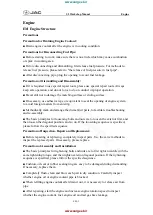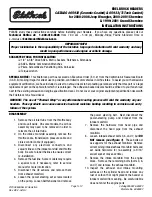
The brake lights do not light up when you brake the
vehicle with the parking brake.
Inf
Infor
ormation about dr
mation about driving on we
iving on wet r
t roads
oads
Hydr
Hydroplaning
oplaning
&
W
WARNING
ARNING Risk of aquaplaning because
tire tread is too low
Depending on the depth of the water on the
roadway, aquaplaning can occur despite su -
cient tire tread depth and low speed.
#
Avoid tire ruts and brake carefully.
Therefore, in heavy rain or other conditions in
which hydroplaning can occur, drive as follows:
R
Reduce your speed
R
Avoid tire ruts
R
Brake carefully
Dr
Driving on
iving on ooded
ooded rroads
oads
Bear in mind that vehicles traveling in front or in
the opposite direction create waves. This may
cause the maximum permissible depth of water to
be exceeded. These notes must be observed under
all circumstances. Otherwise, you can damage the
engine, electrics and transmission.
If you have to drive on stretches of road on which
water has collected, please bear in mind the fol-
lowing:
R
The water level of standing water may not be
above the lower edge of the front bumper.
R
You may drive no faster than walking pace.
Observe the notes on fording while o -road for all-
wheel drive vehicles (
/
page 112).
Inf
Infor
ormation about dr
mation about driving in wint
iving in winter
er
&
DDAN
ANGER
GER Risk of fatal injury due to poison-
ous exhaust gases
If the tailpipe is blocked or su cient ventilation
is not possible, poisonous exhaust gases such
as carbon monoxide may enter the vehicle.
This is the case when the vehicle becomes
stuck in snow, for example.
#
Keep the tailpipe and the area around the
vehicle free from snow when the engine
or the stationary heater are running.
#
Open a window on the side of the vehicle
facing away from the wind to ensure an
adequate supply of fresh air.
&
W
WARNING
ARNING Risk of skidding and of an acci-
dent due to shi ing down on slippery road
surfaces
If you shi down on slippery road surfaces to
increase the engine braking e ect, the drive
wheels may lose traction.
#
Do not shi down on slippery road surfa-
ces to increase the engine braking
e ect.
Vehicles with automatic transmissions are permit-
ted to roll when in neutral
i
for only a short time.
Allowing the wheels to roll for longer, e.g. when
towing, causes transmission damage.
If the vehicle threatens to skid, or cannot be
brought to a standstill when traveling at a low
speed, you can stabilize the vehicle using the fol-
lowing measures:
R
Shi the automatic transmission to neutral
i
.
R
Try to maintain control of the vehicle using cor-
rective steering.
Drive particularly carefully on slippery roads. Avoid
sudden acceleration, steering and braking maneu-
vers.
Have your vehicle winterized at a quali ed special-
ist workshop in good time at the onset of winter.
Observe the notes on snow chains (
/
page 238).
Regularly check the vehicle and remove snow or
ice when traveling in wintry conditions.
An accumulation of snow and ice, particularly
when frozen, in the area around the air intake,
moving parts, the axles, and the wheel wells may
cause the following problems:
R
Obstruction of the air intake
R
Damage to vehicle parts
R
Malfunctions due to restriction of the mobility
intended by the design (e.g. reduced steering
movement)
If there is any damage, inform a quali ed specialist
workshop.
Inf
Infor
ormation about dr
mation about driving
iving o -r
o -road
oad
&
W
WARNING
ARNING Risk of accident if you do not
keep to line of fall on inclines
If you drive at an angle or turn on an incline,
the vehicle could slip sideways, tip and rollover.
112
112 Driving and parking
















































